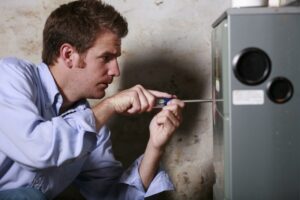Since Fall has started, it important to be prepared for the upcoming winter in Kent. It is a good idea to get yourself ready by learning some basic information about your home’s heating system. For instance, there are many reasons why a gas furnace stops working and in many cases, a homeowner can perform some simple diagnostics to pinpoint the problem. Finding the problem is one thing – fixing it is another. When in doubt, don’t try it yourself. Call a qualified professional.
But let’s look at one possible problem and solution you may be able to perform yourself – testing the draft pressure switch. The draft pressure switch on a gas furnace allows an electrical current to pass through to ignite the furnace. The pressure switch monitors the draft conditions and won’t allow the furnace’s gas valve to open unless draft is correct.
If the switch is malfunctioning, so too will (or will not) the furnace.
The best way to locate the switch is by consulting with your owner’s manual or by going online and simply typing in the words “gas furnace draft switch.” It is identifiable by its round size and is bolted to the outside of the furnace. It should be nearby the draft inducer motor because the two are connected by a metal tube. The tube may sometimes be the culprit, too. A tube that is blocked with condensation may cause the switch to go bad.
To check for proper function, first turn off power to the furnace, either by shutting down the “on’ switch at the furnace or shutting off the circuit breaker.
Use a volt ohm meter to check if the switch is opening and closing properly. Start by zeroing out the meter’s probes by touching the tips together. Using the dial (could be analog or digital), set the meter to 24 volts. Ground the black probe by attaching it to any metal part of the furnace. Then place the end of the red probe on the metal tube connecting the draft pressure switch to the draft inducer motor.
If the switch is working properly the meter should read at least 24 volts, or very near that. If the reading is short of 24 volts, the switch is not working correctly. At that point you may decide to replace it or call a professional to do the task (recommended).
Always remember that there are many sources which will help you diagnose and repair a problem, especially those available through the Internet. If you search YouTube.com you will find many videos advising you on how to repair certain components. Use all of the resources available to you and keep the phone number of a qualified and professional heating and cooling contractor nearby.
Continue Reading
Tags: Furnace, Heating Repair, Kent, Sammamish, University Place
Posted in Heating | Comments Off on How Do I Check a Gas Furnace Draft Pressure Switch? A Question From Kent
 It’s that time of year again–the time where we encourage, even insist, that our customers have their heating systems maintained. Why? Well for starters, maintenance will help your heater last longer! During maintenance, we inspect, clean, and adjust the components that need it. This all reduces wear and tear, which ultimately helps your heating system last the 10-15 years it’s meant to.
It’s that time of year again–the time where we encourage, even insist, that our customers have their heating systems maintained. Why? Well for starters, maintenance will help your heater last longer! During maintenance, we inspect, clean, and adjust the components that need it. This all reduces wear and tear, which ultimately helps your heating system last the 10-15 years it’s meant to.